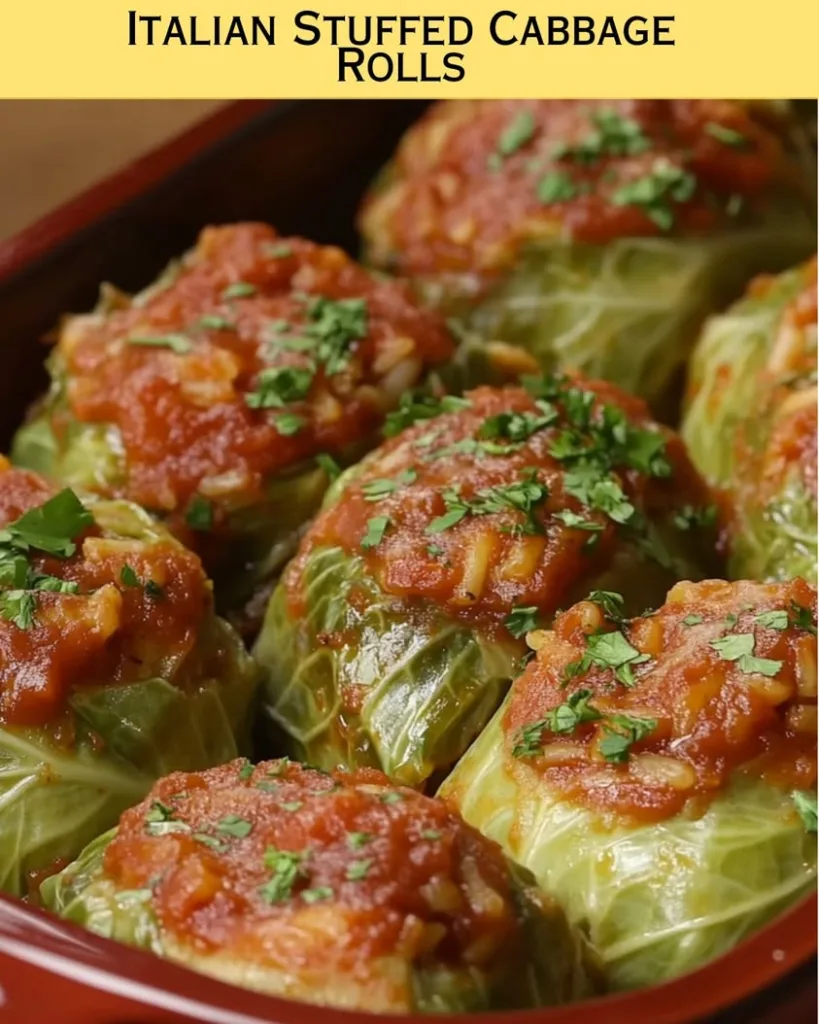Italian Stuffed Cabbage Rolls: A Comforting Classic
Italian Stuffed Cabbage Rolls bring together a symphony of rustic flavors that make this classic dish a staple of Italian comfort food. Made with tender cabbage leaves enveloping a flavorful mixture of ground meat, rice, and herbs, these rolls embody warmth and nostalgia. They’re perfect for family gatherings or cozy dinners, filling the home with inviting aromas as they simmer. Each bite reveals a delicious combination of savory meat, tangy tomato sauce, and fragrant spices that transport you straight to a quaint Italian kitchen.
The visual appeal of the Italian Stuffed Cabbage Rolls is as captivating as their taste, with vibrant green cabbage leaves wrapping around rich, seasoned fillings that peek out just enough to entice your appetite. Drizzled with a luscious marinara sauce and sprinkled with fresh herbs, they look elegant yet comforting. Whether you’re serving them for a Sunday family feast or a special occasion, these rolls are sure to impress.
Quick Recipe Highlights
- Flavor Profile: Rich and savory, these stuffed cabbage rolls combine the hearty taste of ground meat with aromatic spices and a tangy tomato sauce.
- Texture: The dish offers a pleasant contrast between the tender cabbage leaves and the juicy, flavorful filling inside.
- Aroma: The delightful aroma of simmering garlic, onions, and herbs fills your kitchen, making it hard to resist a taste.
- Visual Appeal: The vibrant green of the cabbage and the red of the tomato sauce make for an enticingly colorful presentation.
- Skill Level Needed: This recipe is suitable for cooks of varying skill levels. With a bit of assembly and patience, anyone can master it.
- Special Equipment: A large pot for boiling cabbage, a baking dish, and standard cooking utensils are all you need.
Recipe Overview
- Difficulty Level: While the recipe requires some preparation, the steps are straightforward enough for both novice and experienced cooks.
- Category: This dish falls under main courses and is perfect for meal prep or family meals.
- Cuisine: Rooted in Italian tradition, stuffed cabbage is enjoyed across various cultures with regional adaptations.
- Cost: The ingredients are generally affordable, making this a budget-friendly option for hearty family dinners.
- Season: Best enjoyed during the colder months, this dish warms both body and soul.
- Occasion: Ideal for gatherings, holiday feasts, and cozy weeknight dinners.
Why You’ll Love This Recipe
The taste and texture of Italian Stuffed Cabbage Rolls create a dish that is both hearty and satisfying. The balance of seasoned ground meat and fluffy rice provides a wonderful mouthfeel, while the cabbage adds a slight crunch that contrasts beautifully with the tender filling. Topped with a homemade marinara sauce, each bite bursts with flavor, leaving you craving more.
Another reason to love this recipe is the convenience it offers. Once the rolls are assembled, they can be cooked in a single pot, allowing for easy cleanup. The ingredients can also be prepared ahead of time—cook the meat mixture earlier in the day and roll the cabbage just before serving for a stress-free meal.
Italian Stuffed Cabbage Rolls provide nutritional advantages as well. Packed with protein from the meat and fiber from the cabbage, this dish supports a balanced diet. Pairing it with a side salad increases the variety of nutrients consumed in one meal.
Socially, stuffed cabbage rolls are a great dish for entertaining. They can easily be scaled up to feed a crowd, making them a fabulous choice for gatherings. Share stories around the table as everyone digs into this classic recipe together, relishing the flavors and company.
Lastly, this recipe is cost-effective and accessible. With inexpensive ingredients like cabbage, ground meat, and rice, you can prepare a wholesome meal without breaking the bank. It’s a wonderful way to enjoy comfort food that’s both filling and frugal.
Historical Background and Cultural Significance
Italian Stuffed Cabbage Rolls have a rich culinary history that traverses borders. The origins of stuffed cabbage can be traced back to ancient times and have been recorded in various forms across many cultures, including Russian, Middle Eastern, and Mediterranean cuisines. This adaptability and evolution reflect the dish’s enduring appeal.
Culturally, stuffed cabbage holds significance in many families, often treated as a treasured recipe passed down through generations. In Italy, these rolls are typically associated with festive occasions, where the act of preparing them together becomes a cherished tradition among family members.
The evolution of the recipe has seen many creative variations. While the core ingredients remain similar, regions across Italy have infused their local herbs and meats, creating a diverse tapestry of flavors. Whether using farro in Tuscany or incorporating different cheeses, Italian families adapt the recipe to their tastes and what’s available in their local markets.
Finally, variations of stuffed cabbage reflect the agricultural practices of the time. For example, during the winter months, cabbage was one of the few vegetables available, motivating families to make use of it in hearty meals. Thus, the significance extends beyond taste; it represents sustenance and resourcefulness.
Ingredient Deep Dive
Cabbage is the star ingredient in this dish, renowned for its versatility and nutritional benefits. Historically, cabbage has been a staple vegetable in the Mediterranean diet since Ancient Greece. It offers a wealth of vitamins C and K, as well as fiber, making it perfect for promoting digestion and maintaining healthy skin. When selecting cabbage, look for heads that feel heavy for their size and have crisp, tightly packed leaves. Store uncut cabbage in the refrigerator, where it can last several weeks.
Ground meat is another essential component, often made with beef or pork, reflecting local preferences. The use of ground meat dates back centuries, offering a hearty and economical way to stretch ingredients. Packed with protein and iron, it serves as a significant source of energy. When purchasing ground meat, choose freshly ground options with a good balance of fat for flavor. Ensure it’s stored in the refrigerator and used within a day or two, or freeze it for longer storage.
Rice serves as the binding agent in stuffed cabbage rolls, lending a unique texture and flavor. This staple food has been cultivated for thousands of years and is integral to many cuisines worldwide, including Italian. It provides essential carbohydrates, making it a vital source of energy. When selecting rice, opt for varieties that suit your dish—long grain rice works well here. Cook it separately or mix it uncooked with the meat filling for different textures and flavors.
Tomato sauce, often homemade, is the finishing touch. Tomatoes are celebrated for their rich antioxidant properties, particularly lycopene, which has numerous health benefits. The initial use of tomatoes in Italian cooking traces back to the 18th century, although their adoption took time. Always choose high-quality tomatoes or sauces to enhance the dish’s flavor. Store opened sauces in the refrigerator for up to a week or freeze for longer storage.
Common Mistakes to Avoid
- Overcrowding the rolls: Stuffing the cabbage too tightly can make them difficult to cook evenly, resulting in uneven textures.
- Skipping the blanching: Failing to blanch the cabbage leaves can lead to tough, difficult-to-roll leaves.
- Using uncooked meat mixture: Ensure your meat is fully cooked before assembling the rolls to guarantee the best flavor.
- Insufficient seasoning: Make sure to season the filling well with herbs and spices; otherwise, the rolls may lack flavor.
- Not securing the rolls: Use toothpicks or kitchen twine to secure the rolls properly, preventing them from falling apart during cooking.
- Overcooking the sauce: Ensure your tomato sauce is simmered gently; overheating can lead to a bitter taste.
- Neglecting to cover: Properly cover the dish while baking to keep the cabbage moist and tender.
- Ignoring the resting time: Allow the rolls to rest after cooking for the flavors to meld together before serving.
- Skipping garnishes: Adding fresh herbs or cheese can elevate the presentation and flavor profile of the dish.
Essential Techniques
Blanching cabbage leaves is a crucial first step in preparing Italian Stuffed Cabbage Rolls. This technique softens the leaves, making them pliable and easy to roll. To master this process, bring a large pot of salted water to a rolling boil, and carefully add the cabbage head. Leave it to cook for approximately 3-5 minutes, then transfer the cabbage to an ice bath to stop the cooking process. Look for hints of tenderness but retain the plant’s shape, as overcooking can cause disintegration.
Proper seasoning of the filling is vital for achieving a flavorful roll. Taste the mixture as you prepare it. The goal is to create a balanced flavor that will infuse into the cabbage as it cooks. Pay attention to ingredient proportions, as too much salt or spice can overwhelm the dish. Typically, a combination of garlic, onion, salt, pepper, and Italian herbs work harmoniously for this recipe.
Pro Tips for Perfect Italian Stuffed Cabbage Rolls
– Use fresh herbs for the filling to enhance the flavor profile. Fresh parsley, basil, and oregano can elevate your rolls to the next level.
– If you’re pressed for time, use pre-cooked rice or even quinoa as a substitute for standard rice, reducing prep time.
– Prepare a double batch; these rolls freeze beautifully and are perfect for busy weeknights.
– Experiment with different ground meats such as turkey or sausage to customize flavor and appeal to your family’s tastes.
– When using tomato sauce, simmer it briefly with spices like oregano and red pepper flakes for an extra flavor boost before adding to the rolls.
– Allow the rolls to rest after cooking, as this promotes better flavor integration and enhances the overall meal experience.
– Consider adding grated cheese into the filling, such as Parmigiano-Reggiano, for a richer taste.
– For a healthier version, try substituting some of the meat with finely chopped vegetables or beans.
Variations and Adaptations
Regional variations of stuffed cabbage are plentiful. In Eastern Europe, for instance, you might find rice replaced with barley, which adds a nutty flavor and additional texture. Summer variations often incorporate seasonal vegetables into the mix, allowing for a lighter dish perfect for warm weather.
For those with dietary restrictions, there are multiple adaptations available. You can create a vegan version by substituting ground meat with lentils and using cauliflower rice as a filler. Additionally, if gluten is a concern, ensure to choose rice-based fillers that are gluten-free. On the other hand, if you’re looking for an easy low-carb adaptation, using blanched zucchini ribbons instead of cabbage can provide a clever and light twist.
Flavor variations are also encouraged. You can introduce different cuisines’ spices, such as curry powder or cumin, to lend an exotic flair to the filling. For an Italian twist, add sun-dried tomatoes or olives for added depth.
Presentation alternatives can further enhance your meal. Instead of a plain tomato sauce, consider garnishing the plated rolls with a drizzle of pesto or a sprinkle of pine nuts for an appealing texture contrast.
Serving and Presentation Guide
Plating your Italian Stuffed Cabbage Rolls can elevate the dining experience significantly. Lay out the rolls neatly in a shallow dish, spooning marinara sauce generously over them. For an exquisite touch, sprinkle fresh herbs like basil or parsley on top to create a vibrant contrast against the red sauce.
Garnishing options can enhance the visual appeal and flavor. Parmesan cheese, grated or shaved, adds a delightful finishing touch. Consider pairing the rolls with a fresh side salad dressed lightly with olive oil to introduce a refreshing crunch alongside the meal.
When serving, consider the temperature contrast; warm rolls with chilled accompaniments, such as a yogurt sauce or a light vinaigrette, can create a dynamic eating experience. Additionally, portion control is essential; serving two rolls alongside a generous helping of sauce ensures each guest is satisfied without overindulging.
Consider the serving vessel as well; rustic dishes or wooden boards can bring an inviting feel to your presentation, making it look family-style and perfect for sharing.
Wine and Beverage Pairing
For wine pairings, a medium-bodied red, such as Chianti or Sangiovese, perfectly complements the flavors of Italian Stuffed Cabbage Rolls. Their acidity balances the richness of the meat and tomato sauce, enhancing the overall tasting experience.
Non-alcoholic alternatives such as sparkling grape juice or a fresh Italian soda can also serve well, marrying wonderfully with the savory notes. If you prefer a selection of beverages, consider serving iced tea with lemon, which provides a refreshing counterpoint to the hearty dish.
Temperature plays a role in pairing as well. Red wines should be served slightly below room temperature for optimal flavor, while non-alcoholic drinks can be served chilled to refresh the palate between bites.
For a unique touch, serve coffee or espresso post-meal to conclude the Italian dining experience, capturing the essence of traditional Italian hospitality.
Storage and Shelf Life
To extend the life of your Italian Stuffed Cabbage Rolls, ensure they are stored properly. Leftovers should be cooled to room temperature before being placed in an airtight container. They can be kept in the refrigerator for 3-4 days or frozen for up to 3 months.
The ideal temperature for storage is crucial; refrigeration should be below 40°F (4°C) and deeply freezing at 0°F (-18°C). Make sure to separate individual rolls with parchment paper if you plan to freeze, as it prevents them from sticking together.
Signs of spoilage to watch for include an off smell, discoloration, or mold. Always check your stored food carefully, and when reheating, ensure they reach an internal temperature of 165°F (74°C) to guarantee safety and flavor retention.
Reheating can be done in the microwave or by placing them in a preheated oven covered with foil to maintain moisture. Adding a splash of extra marinara can help revive the flavors.
Make Ahead Strategies
Preparing Italian Stuffed Cabbage Rolls can be streamlined with effective make-ahead strategies. You can assemble the rolls up to a day in advance; wrap them tightly in plastic wrap after preparation and store them in the refrigerator. This allows the flavors to meld beautifully before cooking.
If you prefer to cook ahead, prepare the sauce and filling earlier in the week. Keep them separate until you are ready to combine them, keeping the cabbage rolls fresh. Cooked rolls can be stored in the fridge or frozen for a quick meal at a later time.
Quality can be impacted by freezing; for the best results, make sure they are cooled completely to prevent ice crystals from forming. Once ready to serve, allow them to thaw completely in the fridge overnight before reheating to ensure even heating throughout.
Adding fresh elements before serving is vital, like a sprinkle of fresh herbs or a squeeze of lemon, to brighten the flavors and uplift the dish before you serve it.
Scaling Instructions
In scaling the recipe, whether halving or doubling, ensure your ingredient ratios remain consistent to keep the flavors balanced. For halving the recipe, simply divide each measurement by two, while doubling can easily be achieved by multiplying the original amounts by two.
Equipment adjustments may be necessary when scaling; consider using larger pots or baking dishes to accommodate bigger batches. Check your oven’s capacity to ensure everything fits without crowding, which can affect cooking time and outcome.
Timing will adjust accordingly; larger batches may require slight increases in cooking times, which will be crucial for ensuring thorough cooking. Monitor internal temperatures and overall tenderness closely.
For leftover storage, maintain the same guidelines as the original recipe for best practices. When doubling, be mindful of the amount of storage space required.
Nutritional Deep Dive
The nutritional content of Italian Stuffed Cabbage Rolls can be significant, especially when incorporating a variety of ingredients. A macro breakdown reveals a good balance of proteins, healthy fats, and carbohydrates. The ground meat contributes protein essential for muscle health, while rice provides carbohydrates for energy.
Within the micronutrient analysis, cabbage offers a bounty of vitamin C, while the ground meat provides iron and B vitamins, which are crucial for metabolism and energy production. Additionally, homemade tomato sauce is rich in antioxidants, particularly lycopene, which has been associated with numerous health benefits.
For those managing dietary considerations, be aware of the caloric content, which can vary based on the choice of meat and size of the rolls. Thinly slicing and using lean meat can help reduce calories, beneficial for weight management. Portion control is essential to enjoy this dish while maintaining a balanced diet without overindulging.
Lastly, traditional stuffed cabbage rolls are well-rounded, making them suitable for numerous dietary needs, including those seeking heart-healthy recipes or light yet filling meals.
Dietary Adaptations
Creating a gluten-free version of Italian Stuffed Cabbage is straightforward. Using rice as the binding agent keeps it gluten-free naturally; however, ensure that any broth or sauces used are labeled gluten-free.
For those needing a dairy-free dish, simply omit cheese from the filling and sauce, or substitute with plant-based cheese alternatives, ensuring a delightful flavor throughout without compromising dietary needs.
Vegetarians can relish this dish by eliminating meat and replacing it with quinoa, lentils, or a medley of seasonal vegetables for a filling option that retains the heartiness of this classic recipe.
If you’re following a low-carb or ketogenic diet, consider substituting traditional rice with cauliflower rice. This innovative version maintains the integrity of the dish while significantly reducing carbohydrates.
Paleo dieters can enjoy a version that aligns with their dietary practices by utilizing lean meats, skipping processed sauces, and focusing on natural ingredients.
Troubleshooting Guide
Texture issues can arise if cabbage leaves are undercooked or overcooked. Monitor the blanching time closely; they should be pliable yet sturdy. If the rolls end up too tough, an ice bath can halt cooking and preserve tenderness for further use.
Flavor balance is essential; if too bland, remember to taste the filling before assembling, adjusting herbs and spices as needed. Over-salting remains a common issue, so measure your ingredients carefully and taste-test as you go.
Temperature challenges may emerge during cooking. If the rolls are cooking unevenly, consider rotating the dish halfway through the baking process to ensure even heat distribution. Using a meat thermometer is helpful for checking doneness.
Ingredient substitutions can lead to challenges in flavor or texture. When making swaps, be conscious of similarities in moisture content and fat ratios. For instance, using white rice instead of brown will yield different textures.
Timing concerns are common when preparing multiple dishes. To avoid overcooking, ensure to monitor the time closely, and prepare all components beforehand to streamline assembly.
Recipe Success Stories
Community feedback surrounding Italian Stuffed Cabbage Rolls shows a mix of nostalgia and innovation. Many families cherish this recipe, often sharing it as a way to gather around the dining table and enjoy home-cooked meals. Children often delight in helping to roll the cabbage, creating cherished memories alongside the meal.
Variation successes come from readers who have adapted the ingredients to suit dietary preferences or regional influences. Many have reported satisfaction in substituting different grains, resulting in delightful results like quinoa-stuffed cabbage, showcasing the dish’s flexibility.
Adaptation stories included instances of professional chefs presenting their unique takes, such as incorporating spicier elements or local ingredients. This highlights the dish’s wide appeal, transitioning from home kitchens to gourmet restaurants.
Readers often share photography tips, celebrating the visual aspect of cabbage rolls after careful assembly. Presentation has inspired many home cooks to engage with this dish visually, elevating their family meals and impressing guests.
Recipe suggestions often pop up in conversations about this dish, with adaptations shared through social media, transforming traditional recipes into modern household staples while maintaining the comfort of their origins.
Frequently Asked Questions
Can I make the filling ahead of time?
Absolutely! You can prepare the filling a day before, allowing the flavors to meld. Just keep it stored in the refrigerator until you’re ready to assemble the rolls.
What if I don’t like ground beef? Can I use something else?
Yes! Ground turkey, chicken, or even plant-based meat substitutes work well in this recipe. Choose whatever suits your taste preferences for a personalized dish.
How do I prevent the cabbage from tearing while rolling?
Blanching the cabbage leaves before rolling them effectively softens their structure, making them more pliable and less likely to tear during assembly.
Can I freeze the stuffed cabbage rolls after cooking?
Yes, you can freeze cooked cabbage rolls! Just cool them completely and store them in an airtight container for up to three months. Reheat in the oven before serving.
What can I pair with stuffed cabbage for a complete meal?
A light salad or garlic bread pairs beautifully with stuffed cabbage. Additionally, roasted or steamed vegetables complement the dish’s flavors and offer a nutritious side.
Is it necessary to cover the dish while baking?
Yes, covering the dish helps retain moisture during baking, ensuring the cabbage stays tender and preventing it from drying out.
What herbs work best in the filling?
Italian herbs such as oregano, basil, and parsley enhance the flavor of the filling wonderfully. Experimenting with fresh herbs can add a delightful freshness to the dish.
How long do leftovers last in the fridge?
Leftover stuffed cabbage rolls can last up to four days in the refrigerator when stored properly in an airtight container. Make sure they’re cooled before sealing.
Will the rolls taste the same if I prepare them in advance?
Yes, making them in advance can even enhance the flavors as they have more time to meld together, creating a richer taste when it’s finally time to bake them.
Can this recipe be made gluten-free?
Indeed, this recipe can easily be adapted to be gluten-free by using gluten-free sauces and ensuring your meat fillings don’t contain any hidden gluten ingredients.
Additional Resources
If you enjoyed preparing these Italian Stuffed Cabbage Rolls, you might also like similar recipes that combine comfort and flavor. Explore our collection of traditional Italian dishes or delve into other stuffed recipes, such as stuffed peppers or zucchini.
For detailed technique guides, check our articles on mastering boiling, blanching, and using herbs effectively. You can also find ingredient information to help you choose the best quality produce and meats when preparing your meals.
If you’re interested in seasonal variations, consider taking a look at our other winter recipes that keep you cozy all season long. Adapt your cooking according to what’s fresh to ensure the best flavors and nutritional benefits!
Join the Conversation
We love hearing your thoughts and experiences! Feel free to share your rendition of Italian Stuffed Cabbage Rolls on social media by tagging us. Your photographs and variations can inspire others in their cooking adventures, creating a community of passionate home cooks.
Looking for recipe reviews? Join our forums where home chefs share what they’ve tried, their successes, and modifications, enriching everyone’s cooking experience.
Share your unique ideas for variations, garnishes, and serving styles to spark a dialogue on how we can innovate this classic dish. Together, we can explore and celebrate the joys of cooking and sharing meals in good company.
The Recipe
Italian Stuffed Cabbage Rolls
Serves: 4 servings
Prep Time: 20 mins
Cook Time: 40 mins
Total Time: 60 mins
Kitchen Equipment Needed
- Large pot for boiling cabbage
- Baking dish
- Cooking utensils (spoons, measuring cups)
- Knife and cutting board
- Mixing bowl
Ingredients
- 1 large head of green cabbage
- 1 pound ground beef
- 1 cup cooked rice
- 1 large onion, finely chopped
- 3 cloves garlic, minced
- Salt and pepper to taste
- 1 teaspoon dried oregano
- 1 teaspoon dried thyme
- 2 cups marinara sauce
- Fresh parsley for garnish (optional)
Directions
- Bring a large pot of salted water to a boil.
- While the water is heating, prepare the filling by combining ground beef, cooked rice, chopped onion, minced garlic, salt, pepper, oregano, and thyme in a mixing bowl.
- Once the water is boiling, blanch the cabbage leaves for about 3-5 minutes until they are tender but still firm.
- Remove the leaves from the pot and set them in a bowl of ice water to stop the cooking process.
- Preheat your oven to 350°F (175°C).
- Take one cabbage leaf at a time, placing a 2-3 tablespoon portion of the filling at the base of the leaf. Roll it tightly, tucking in the sides as you go. Repeat with remaining leaves and filling.
- Place the stuffed cabbage rolls seam-side down in a baking dish. Pour marinara sauce over the top, ensuring the rolls are well coated.
- Cover the dish with foil and bake for 30 minutes; then, uncover and bake for an additional 10 minutes to brown slightly.
- Let them rest for a few minutes before serving. Garnish with fresh parsley if desired.
Recipe Notes
- Feel free to substitute the ground beef for turkey or chicken.
- Use brown rice for a whole grain alternative, but adjust cooking time accordingly.
- These rolls can be frozen for later use; just ensure they are fully cooled and stored properly.










